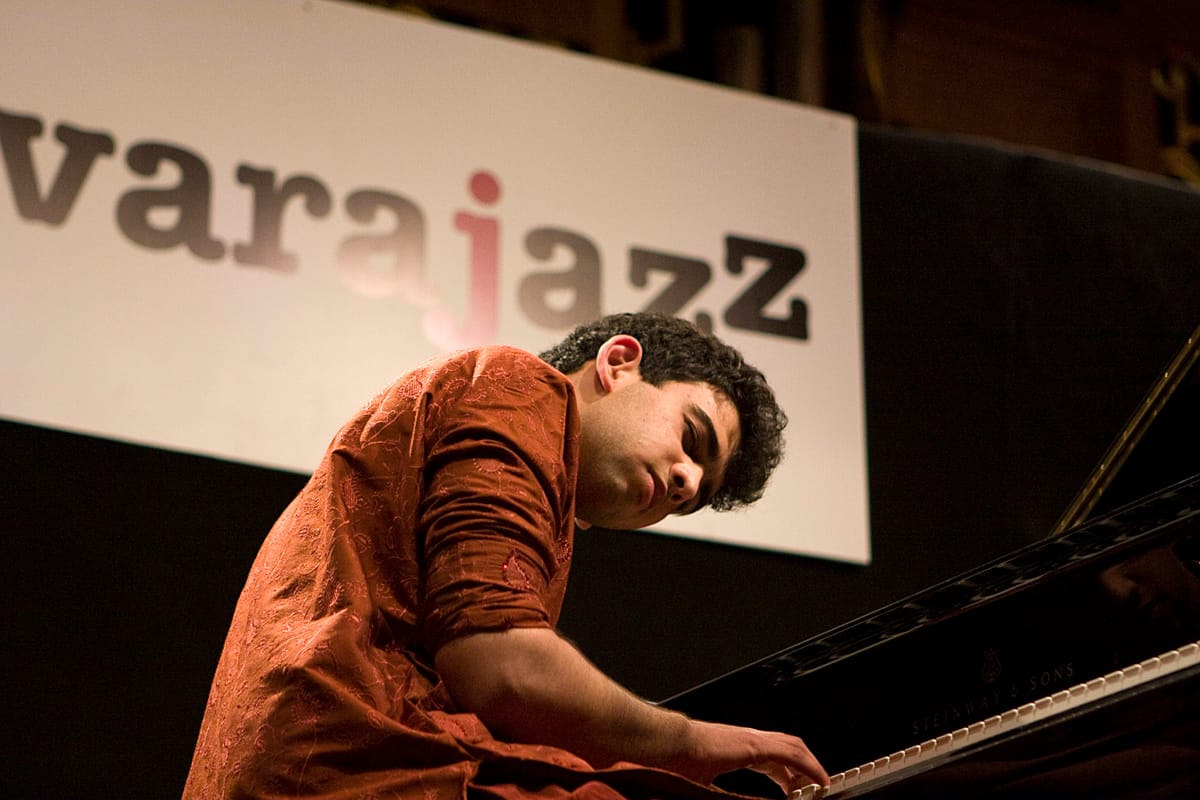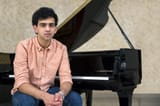Breaking Boundaries

My fascination for the piano came very early and way before my foray into Indian Classical music. In the initial years while I played both Western Classical and Indian film music on the piano, it was the raga based film music that first pulled me towards Hindustani Classical. I also found that I wanted to explore my own voice on the instrument and started leaning towards improvised forms of music. Exploring Indian classical music, I was stunned by its beauty, overwhelmed with its complexity and totally drawn to the challenge of expressing raga music on piano. It instantly felt like a deeper form of music to what I had been exposed. There did not seem to be many other pianists who had performed this music and I was determined to explore the potential of the instrument for this music. I started transcribing sitar, santoor and flute recordings and researching books to explore ways to play the ragas on the piano.
In 2006, my family moved to Dublin which suddenly opened doors in terms of exposure to Western classical music, master-classes and also jazz. I began advanced piano training under Padhraic O’Cunneagain at the DIT Conservatory of Music and went on to the finish my ATCL Diploma with Distinction from Trinity College, London. Along with classical piano, I wanted to study jazz because it was a form of music that like Indian classical music, was steeped in improvisation. While in Dublin, I started taking evening lessons for Jazz under Argentinian pianist Germann Lema and also attending the weekly jam sessions under Tommy Halferty at the Newpark School of Music, an affiliate of the well-known Berklee School of Music, Boston. I was also awarded a full scholarship in June 2008 to attend a 5 week performance program in Jazz at Berklee which was a great learning experience. Subsequently, I went onto Royal Conservatoire of Scotland, Glasgow to complete my Honors Bachelor of Music degree in Jazz Piano as a recipient of their full tuition ABRSM Scholarship.
While jazz is a huge and welcoming genre in music which can embrace almost any style and it has become a huge part of my musical identity, my main focus has been to establishing the piano as an Indian classical instrument.
It was not easy right at the start, particularly in India since the piano is not a traditional Indian classical instrument. There was no guru to learn from and amongst the biggest stumbling blocks in playing Ragas on Piano were the “meend” stretching of notes that is practiced in Indian classical music and the shrutis or microtones which are hard to achieve/tune on the piano. This is why I think people have stayed away from using it for Indian Classical music. However, my approach was that rather than take piano to ragas. I have tried to bring the raga closer to the piano i.e. instead of dwelling on what was not possible, I looked to use the many advantages of the piano to adorn the ragas and use its strengths to beautify the rendition. The piano offers innumerable possibilities to explore soundscapes and is one of the most expressive and versatile instruments. I have therefore used my training in western classical music to strengthen my technique on the piano and my work in jazz to look at improvisation in a different light. I try to fuel all of experiences into my playing so that I can communicate the essence of the raga in its pure form. My aim when I play the Piano is to make the instrument sing and use it as a tool for expression of the musical ideas in my head.
After initial years of experimenting on my own, I finally found my guru in Ustad Wasfiduddin Dagar. The Dagar family has been at the forefront of the dhrupad style of Indian music for over twenty generations and the depth and sincerity with which the music is rendered resonated very well with my own musical ideas. Additionally, to understand the facet of Instrumental style of music in North Indian classical music, I have been mentored by the incredible violinist Sharat Chandra Srivastava for several years.
In the early years of my career, I received more invitations from outside of India and developed a better following internationally since for the western audiences, the piano was an instrument they were familiar with and the sound of ragas was new and fascinating for them. But I have been working for over 13 years in this area and the last 5-6 years have been fantastic as it has finally drawn so much support for my efforts from the Indian classical community as well. The beauty of the piano as an instrument and the depth of the raga tradition blend so well together that milestones such as the invitation to introduce the piano for the first time at the renowned Indian music festivals such as Saptak or at the 137th edition Harivallabh Sangeet Sammelan, which is India’s oldest classical music festival, have been hugely motivational and great validation for my work. Recordings and videos of legends performing at these festivals have always been huge inspirations for me and it was incredible to be able to be on the same stage and introduce my music there. I have also had the chance to work on duet /jugalbandi concerts with well-known classical maestros like Ustad Hidayat Khan, Pandit Rakesh Chaurasia, Pandit Samir Chaterjee and others.
On a separate note, I have recently recorded in the United Kingdom, the world’s first album on a ground breaking new instrument called the Fluid Piano. Invented by Geoff Smith, the Fluid Piano is a completely acoustic grand piano which allows a musician to alter the individual frequencies of each note through a slider that varies the string tension in real time. This makes the microtones much more accessible and the note can be bent and altered once played. It’s the first time in the history of the piano that someone has built a version that can achieve this which instantly makes the instrument a lot more accessible to world music traditions that are not focused on equal tempered tunings. Hence when playing this instrument, meends (bends), pure microtonal intonations and andolan (oscillations) are available to the pianist. The album will be released worldwide by the Fluid Tuning Piano label in Mar 2016.
I’m determined to take Indian classical music to new audiences around the world and over the last few years have had to chance to play in some very special venues and situations. Amongst the highlights and memorable concerts would be performing raga music at the Novara Jazz Festival, Italy, Symbiosis of Sound Festival at Kings Hall, London, Theatre Orangerie in The Netherlands, and Southbank Centre in London. I have also been fortunate to perform at iconic venues such as Carnegie Hall in New York and The John F Kennedy Centre in Washington DC. These venues are like a mecca for musicians around the world and performing a concert there will be a lifetime treasurable memory.
I’ve always loved collaborating with other musicians and in December 2014, I got a chance to play with two of my idols, Irish fiddle and guitar duo Martin Hayes and Dennis Cahill. Since I first heard them in Dublin in 2006, the beauty and simplicity of their music and their work with bands such as the Gloaming really overwhelmed me and the chance to spend time and perform with them was an amazing opportunity. I think exposure and involvement in diverse styles is one of the most rewarding aspects of music. Ultimately no matter whether I’m playing ragas following the strict rules, or playing some Irish reels or doing a free improvisation, every single musical experience of my life is there as a resource. It’s extremely important when learning a style of music to go into a huge level of detail and respect the rules and boundaries of that style. However, I do believe that it’s equally important and rewarding to cross those boundaries consciously and explore music that is unburdened by restrictions. A lot of my musical influences are those who have done this such as composer and pianist Terry Riley, guitarists like Blake Mills and Bill Frisell, pianists such as Tigran Hamasyan or Thomas Bartlett. When I play Indian classical music I do my best to play the purest form of the raga but I know that I could use phrases I’ve transcribed from a Coltrane solo or a Tom Waits melody line as a springboard for a taan. Inspiration can come from anywhere and it’s essential to always keep your ears open.
For young musicians who are working towards fulfillment of their musical dreams, I would say that our rich tradition of music has enough wealth of material in it to inspire us for centuries. I would urge any musician to listen and absorb as much Indian music as they can no matter what their chosen field is. It’s also important to learn from everything you listen to whether it’s a tune on the radio in the back of a cab or a huge symphony played by a top orchestra or just a street musician playing some great songs. Every musical sound has infinite potential to be developed and learned from.
Also, being taught by the right people is equally important to any musician. All my teachers and gurus especially Wasifuddinji and Sharatji in Indian music ,Paul Harrison my jazz tutor at the RCS and Padhraic O’Cunneagain ,John Raphael for classical piano have been irreplaceable pillars for my musical development and also great humans who have taught me life skills for which I am eternally indebted to them.





